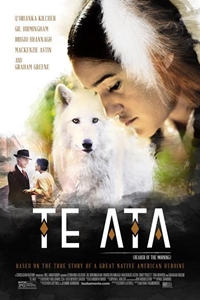Te Ata
Director: Nathan Frankowski
Starring: Q’orianka Kilcher, Boriana Williams, Gil Birmingham, Brigid Brannagh, and Graham Greene
Storytelling is a cultural component for Native American people. It is the way history, tradition, and religion are shared and nurtured across the near 566 federally recognized tribes in the United States. Each tribe, a unique and individualized community, shares these stories in different ways, whether through spoken story, song and dance, or through written history.
For the Chickasaw Nation, originally from the southern regions of Mississippi, Kentucky, Alabama and Tennessee but forcefully removed and migrated to Oklahoma, the stories they share are rooted in nature and the elements. For Chickasaw native Mary Thomas Fisher, storytelling would change her life and make her an important figure for Native American cultural barriers and changes in perceptions during the 1920’s and lasting into the 1980’s. Ms. Fisher was better known by her stage name Te Ata, which means “bearer of the morning”.
Produced by the Chickasaw Nation, the story of Te Ata comes to life with a passionate performance from Q’orianka Kilcher, who had her breakout role as Pocahontas in Terrance Malick’s “The New World” in 2005.
The biopic documents the rise of the Native American actress, dancer, and storyteller through her journey as a child living on the Chickasaw reservation, into college at the Oklahoma College for Women, and onto a performing career with a traveling show and theater career in New York City. Along the way Te Ata discovers her identity as an artist and advocate for Native American cultural expression. Leading her to opportunities that were significant steps for Native people but also women during a time when neither were given much prospect.
“Te Ata” boasts exceptional production value throughout; the costumes look great and the sets are well polished, all of it accommodated by the photography that offers a clean high definition perspective. It makes the natural landscapes, the rivers and vast plains, glow with beauty.
The linear storytelling structure of the film works just fine, though in some moments it becomes a little monotonous. And because the film is working to tell a life’s story, the highlights of Te Ata’s life take away from some of the interesting points that made her life so important. The positive perspective makes this film uplifting and an admiration for a culture that helped change how many in the world perceived Native Americans. However, the negative aspects that still linger so many years later for Native people also tell a story. While the film hints at these aspects, specifically in a scene involving the stereotyping of Native Americans in film, it mostly passes over the elements of discrimination and racism that were definitely present during this time.
Early in the film Chickasaw Governor Douglas Johnston (Graham Greene) makes the statement, “We are a patient people, we will get what is ours, even if it takes 100 years”. This statement is made during discussions concerning the Code for Indian offenses, which during the early 20th century aimed for the abandonment of traditional practices and the assimilation of Native Americans into western obedience. Fast forward 100 years later and Native Americans are still fighting for their culture, their well-being, and their land.
Still, stories like Te Ata’s are pertinent to understanding the role that culture plays for indigenous people but also any person who may come from a diverse, unique, or different background. We all have stories to tell, voices that should be heard, and Te Ata’s story seems very relevant in the divided world we are living in today.
Monte’s Rating
3.25 out of 5.00










